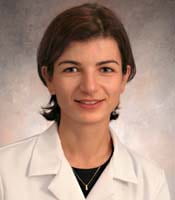Research Areas
Acute Lung Injury
Research in the mechanisms of acute lung injury focus on the diversity of cell types in the lung. At the University of Chicago, we defined the mechanisms behind how endothelial and epithelial cells barriers break down during lung injury, which occurs in a RhoA dependent reorganization of cortical actin to stress fibers. Recently, we discovered that important hemodynamically active transcription factor KLF2 in endothelial cells is necessary to prevent cell injury and death, but is absent, with excessive stretch and under lipopolysaccharide treatment. We also discovered that KLF2 is reduced in COVID19 ARDS.
Our section also studies the innate and adaptive immunity in lung injury and repair.
Recent publication highlights [more]:
Basic Science
Basic science research in the Section of Pulmonary and Critical Care Medicine is related to disease pathobiology, but extends beyond to investigation of fundamental mechanisms which are present in most cells.
Recent publication highlights [more]:
Asthma
The University of Chicago has a rich history of contributing to advances in asthma research. In the recent years, faculty have participated in some of the largest genome-wide association studies (GWASs) of asthma and related phenotypes to discover new genetic risk loci. Deciphering the effects of genetics and environmental risk factors for asthma on immune regulation continues to be an active area of research. This work is accompanied by programs that focus on the effects of asthma-relevant genes such as IL33 and TLSP on immune responses in asthma models. Additional projects are aimed at determining how smooth muscle contraction contributes to pathogenesis. The section supports the UChicago Lung Biobank which is actively harvesting lung smooth muscle, epithelial cells and immune cells from human organ donors and serves as a rich research resource.
Recent publication highlights [more]:
Innate Immunity and Asthma Risk in Amish and Hutterite Farm Children. New Eng. J. Med. 2016 Aug 4;375(5):411-421. doi: 10.1056/NEJMoa1508749
Critical Care Outcomes
PCCM at the University of Chicago has been a leader in practice-defining and paradigm-shifting clinical trials. Historically, our section discovered that tidal volume lung inflation was critical for initiating lung injury. We also found that the use of benzodiazepines for sedation leads to increased time on the ventilator and cognitive impairment, both of which worsen mortality. We led the effort for daily awakenings and early mobilization which also reduces time in the ICU. Recently, we discovered that the use of helmets could spare invasive ventilation in patients with acute hypoxemic respiratory failure. We continue to ask practice changing questions in the Critical Care Outcomes Group.
Recent publication highlights [more]:
Healthcare Ethics and Allocation
Health care systems research in the Section utilizes advanced data science methods such as deep learning and simulation modeling to organ allocation, designing systems that efficiently and fairly allocate these scarce health care resources to the patients most in need. We also are focused on understanding and preventing ICU readmissions using novel machine learning methods to electronic health record data to identify patients at highest risk of preventable ICU readmissions.
Recent publication highlights [more]:
Practice Changes at U.S. Transplant Centers After the New Adult Heart Allocation Policy
Pulmonary Fibrosis
The Pulmonary Fibrosis and Interstitial Lung Disease Research Group at the University of Chicago is internationally renowned for its contributions to the development of novel pharmacotherapeutics and management strategies that improve the quality of life of our patients with interstitial lung disease (ILD).
As a leading center in the field over the past two decades, our work has led to trailblazing discoveries in the pharmacogenomics of pulmonary fibrosis and numerous advances in ILD immunopathobiology. Our research has defined the value of proteomics in prediction modeling, characterized the multi-organ effects of autoimmunity in pulmonary fibrosis, and highlighted the impact of environmental exposures on disease definition and progression. We identified the single-nucleotide polymorphism within the TOLLIP gene (rs3750920) as the first actionable pharmacogenomic variant in the field of pulmonary fibrosis and recently depicted the association of telomeres with response to immunosuppressive therapy in hypersensitivity pneumonitis. Our group also recently defined distinct ILD clusters based on clinical phenotypes at disease diagnosis and characterized the importance of lung lymph nodes visualized on chest CT images as prognostic indices of hospitalization and mortality across various ILD subtypes. Our application of cutting-edge imaging technologies and radiomics-focused data characterization algorithms has helped define the clinical utility of the usual interstitial pneumonia pattern and the prognostic value of CT features such as radiologic honeycombing.
With one of the largest prospective ILD databases in the nation, our center has partnered with others to facilitate a greater understanding of ILD epidemiology and provide greater insight into the demographic, socioeconomic, and environmental factors impacting the development of pulmonary fibrosis. Under the leadership of Dr. Mary Strek and in collaboration with local and international experts at numerous hospital centers, we have conducted multi-center clinical trials such as INBUILD, PANTHER-IPF, CLEAN-UP, and ACE-IPF. These efforts have resulted in the development of life-changing treatments and delineating pharmacotherapeutic value for patients with fibrotic lung disease. As a nationally recognized center with ILD expertise and an official Pulmonary Fibrosis Foundation Care Network site, we offer patients the opportunity to participate in drug trials for promising pulmonary fibrosis therapies and enrollment in several ongoing ILD registries.
Recent publication highlights [more]:
Sleep
We are interested in studying the links between sleep and metabolic, endocrine and cardiovascular functions, and on the role of sleep disturbances in the development of metabolic and endocrine abnormalities including type 2 diabetes, obesity and metabolic syndrome. Our section has a strong focus on obstructive sleep apnea, with a specific focus on REM-related sleep-disordered breathing, perioperative complications in patients with sleep apnea, as well as best treatment strategies in patients with obesity hypoventilation syndrome.
Recent publication highlights [more]:

















